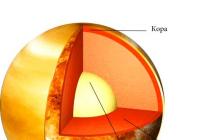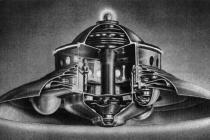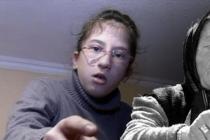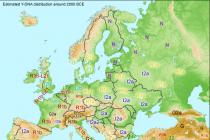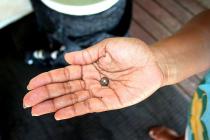In 1820, a stranger in Virginia, Thomas Bale, left a box of important documents for safekeeping at a hotel. When, after 12 years, it became clear that the owner of the papers would not return, Robert Morris opened the box ...
R. Morris, a native of Maryland USA, began his career as a tobacco wholesaler in Lynchburg, Virginia, and initially did very well, amassing a considerable fortune and greatly expanding his trade, which was rather modest at first. However, fluctuations in the price of tobacco and his own propensity for a somewhat adventurous business, soon brought him almost to ruin.
Forced to start again from scratch, Morris, however, thanks to his good-natured character and "unshakable honesty" managed to maintain the friendship of many prominent citizens who came to his aid in a difficult moment. With the remaining and borrowed money, he managed to rent the Arlington Hotel for ten years, and when things went smoothly, and this hotel became one of the best in the city, he also rented the Washington Hotel, where a man became his guest. surname Bale.
"He was about six feet tall," Robert Morris recalled of Thomas Jefferson Bale - his eyes were agate black, his hair was the same color, I must say, he wore his hair a little longer than it was supposed to be in the then fashion. He was well built and strongly knocked down , his whole appearance spoke of extraordinary strength and vigor, despite the fact that his skin was weathered, dark and rough, tanned from the sun and wind, however, this did not spoil him in any way. haven't met yet."
According to the pamphlet, a man named Thomas J. Bale, a buffalo hunter, first appeared in Lynchburg, Virginia in January 1820. "in search of rest and entertainment" accompanied by two friends who soon left, and remained at the Morris Hotel until the beginning of March.
He never told anything about himself or his family, however, by some indirect evidence, Morris suggested that he was a native of West Virginia, a fairly educated and wealthy man, however, Bale was distinguished by a clearly adventurous nature and a tireless craving for adventure, not allowing him to stay in one place for a long time.
The second and last time he appeared in January 1822 and left again, this time forever, at the beginning of spring, leaving Morris for safekeeping an iron box locked with a key, "in which lay papers of exceptional importance." May 9the same year Morris received a last letter from T. J. Bale, in which the latter announced that he was going to hunt buffalo and grizzly bears on the great plains, intending to return to Lynchburg in 1824. This information was accompanied by a request that the abandoned box be kept in complete safety until his return or the appearance of a messenger sent by him, and if neither ultimately happened, to be opened after ten years.
Morris really waited until 1832, when it became clear that there was no more hope for Bale's return.At this time there were persistent rumors of Indian raids and brutal killings of whites, but Bale's name was never mentioned. What happened to him and his companions remains unknown. Whether he died at the hands of the Indians or was torn to pieces by wild animals in the Rocky MountainsWhether he froze or died of hunger remained forever unknown. One thing was clear - out of the whole cheerful company of young and gallant men, whose seething cheerfulness inspired them to search for a life full of adventure and risk, leaving the comfort and modest joys of home life for the dangers and hardships that awaited them in the very near future, did not remain alive no one.
If you believe the second, very lengthy letter, in 1817 Bale, together with a detachment of 30 people who chose him as their "captain", went as it was customary for him to hunt on the Great Plains. A guide and several servants were hired to help, the detachment was well armed and equipped with everything necessary in order to spend about two years away from civilized places.
Bale's men spent the winter of 1817 in Sante Fe, a city at that time in Mexico. Waiting for the weather to settle down, several people from the detachment in March of the following year, 1818, went on a short hunting excursion, which, however, dragged on for a month. Those who remained were about to send out a rescue party to search for them, when several hunters reappeared with unexpected and joyful news that, while pursuing a herd of buffalo, they quite by chance managed to stumble upon a rich gold mine, located "somewhere 250-300 miles north of Santa - Fe. The hunt was immediately abandoned, and for the next eighteen months the hunting party, and later the rest of the detachment that joined it, took up gold mining. The accompanying metal was silver, and so much of both was mined that Bale's companions could consider themselves secure for the rest of their lives.
However, the question arose to transport what was found to the territory of the United States, "where it alone could remain safe." This mission was undertaken by Thomas Jefferson Bale, who, accompanied by ten satellites, delivered what was originally found to St. Louis (Missouri), where part was exchanged (in order to facilitate transportation) for precious stones, and then hid it in an underground mine “near Buford” .
Morris, however, preferred to wait until 1845., and finally decided to pick the lock.In addition to receipts and letters, three sheets were found in the cache, covered with a number of numbers. Morris spent several years deciphering the cryptic pages. From the cover letter it followed that in 1817 Bale, along with his detachment, attacked a gold mine. The extracted treasures were safely hidden, and the ciphers told the exact location of the treasure and its description.
In 1862, the aged Morris gave the sheets to a young friend of his. To James B. Ward. By early 1885, James B. Ward was ready to admit defeat and give up trying to solve the mysterious cryptograms. Twenty years of hard work brought very limited success, and he seemed to have no chance of solving this most difficult problem for the rest of his life.
After much deliberation, Ward decided to make this secret known only to him alone the property of the general public: what if someone still manages to succeed! So in 1885 in Lynchburg (Virginia) a small pamphlet was published with a very long title: “Bale's papers containing genuine information regarding the treasure buried in 1819 and 1821. near Bufords in Bedford County, Virginia, and which has never been found."
In this pamphlet, Ward told a strange story that he learned twenty years ago from a certain Robert Morris, owner of a hotel in Lynchburg. In 1817, a man named Thomas Jefferson Bale led a party of thirty men from the western United States to hunt buffalo in northern New Mexico. Somewhere there, Bale and his comrades stumbled upon a rich gold mine. Hunting, of course, was immediately forgotten, and the hunters turned into miners. By 1819 they had accumulated considerable reserves of gold.
But what to do with him in this desert area, where at any moment you can run into Apaches or bandits? According to The Bale Papers, “…the question of transferring our wealth to a safer place has been discussed frequently. It was undesirable to store such a large amount of gold in such a wild and turbulent place, where the possession of it could endanger our lives. It was pointless to hide it there, since under duress, any of us could at any time indicate the location of the hiding place.
As a result, the prospectors decided to transport the gold by van to Virginia. For two flights they managed to deliver 2921 pounds of gold and 5100 pounds of silver.For the time being, the treasure was buried in iron pots about six feet below ground level, in a secret cellar roughly lined with stone. The Bale group elected Robert Morris of Lynchburg as its confidante, as the Papers say. Going west for the third and final piece of cargo, Bale gave Morris a sealed metal box and strictly ordered that this box should not be opened until ten years later and only if no one from Bale's party returned to Lynchburg during this time.
Honest Morris unsuccessfully waited for the miners not even ten years, but twenty-three years. When it finally became clear that Bale and his people would never return - they probably laid down their lives in the mountains of New Mexico - Morris opened the mysterious box. In it, he found a sealed package, and in the package - three cryptograms and a letter briefly explaining the meaning of this "message to posterity." The cryptograms contained secret information about where the first part of Bale's treasure was buried. Using the keys contained in the cover letter, Morris was to decipher these cryptograms, find the treasure, and distribute the gold and silver among the direct male descendants of the miners, if any.
Each cryptogram consisted of a series of numbers ranging from one to three digits. However, no matter how much Morris did not shake the envelope, how much he did not reread the letter, how much he did not turn the tin box, he did not find any promised keys to the cipher. What to do? At his own peril and risk, Morris tried to decipher the mysterious cryptograms, but he did not succeed. In 1863, about a year before his death, he initiated James B. Ward into the secret. And... quite by accident, Ward managed to solve the mystery of cryptogram number 2!
The key to it turned out to be the text of the US Declaration of Independence, and the text of the cryptograms was a list of the contents of the cache left by Bale and his comrades. In this case, the other two cryptograms, in my opinion, contain information about the location of the cache and a list of people who were part of the Bale group, whose heirs are to be found. However, despite all attempts, Ward was never able to decipher these two cryptograms.
In 1885, Ward, in his own words, "decided to get out of this business once and for all, and to relieve my shoulders of the burden of responsibility to the late Mr. Morris ... For this I did not find a better way how to make the secret public."
Since the publication of Ward's pamphlet, many people have tried to decipher the mysterious cryptograms. Most enthusiasts have not been able to do this. Others, after many attempts, eventually managed to obtain more or less coherent texts, but for some reason all these decryption options differed radically from each other, and attempts to find treasures based on them each time led to disastrous results. Finally, others, having waved their hand at the texts, simply began to dig up the ground in the state of Virginia, hoping to find the treasure by the “poke method”. Clairvoyants, dowsers, and finally bulldozers were used to find Bale's treasure... The temptation was great: in 1982, one journalist calculated that the modern value of the treasure could be $30 million.
In 1968, the Bale Cipher Association was even founded. This group hoped, by pooling their resources and talents, to finally solve the mystery of the mysterious cryptograms. Much effort was expended in finding documents that could shed light on the fate of Bale and his comrades, and texts that could serve as keys for deciphering cryptograms No. 1 and 3, just as the Declaration of Independence served as a key for deciphering cryptogram No. 2.The efforts of the association in this direction were in vain, but quite unexpectedly, another path opened up before the researchers.
How reliable are the Bale Papers and who is their true author? Without an answer to this question, all further searches are meaningless. Researchers have searched the archives for traces of Thomas Jefferson Bale, but have found no evidence that a person by that name existed in Virginia in the early 19th century. Also. there are no documents confirming the fact that in the late 1810s a party of hunters or prospectors left Virginia westward to New Mexico or California. Finally, it has been established that the original "Bale Papers" - that is, the original texts of the cryptograms and the accompanying letter to them - do not exist. Back in the 1880s, Ward reported that they allegedly died in a fire. The question naturally arises: is not this whole story a hoax?
The researchers drew attention to a number of minor errors contained in Ward's brochure: a mismatch of dates, the presence of neologisms that are not characteristic of the language spoken in America in the 1820s, a mismatch of names ... For example, in Bale's letter, traditionally dated 1822, in the description running herd of bison used the word "stampede" - "stampede". However, this word (from the Spanish "estampida") entered the American lexicon no earlier than 1844, twenty-two years later.

If The Bale Papers is a hoax, then who could have been its author?Apparently Bale himself (if he existed), Morris and Ward. It is the latter that most skeptics point to. A lexical analysis of the text of the pamphlet published by Ward showed that all the texts in it (including the texts of the Bale letters) were most likely written by a single person, most likely Ward. Moreover, unlike Bale, the historicity of Ward's figure is beyond doubt.
What inspired Ward to write this story? Some researchers point to the story of Edgar Allan Poe "The Gold Bug", where there are similar details of the plot. Another source could be a Kentucky legend about a man named Swift who discovered a silver mine that is still considered lost.
But if the Bale Papers are just fiction, then what do the two undeciphered cryptograms contain? Or are they just a random collection of numbers?
However, computer analysis of cryptograms in 1971 showed that there are cyclical correspondences between numbers that cannot be considered random, and that in both cases the cryptograms are text encoded in the same way as cryptogram No. 2. Only the key (or the keys) to this cipher should be sought not in the Declaration of Independence, but in some other texts ...
What can the undeciphered messages tell us? Tell me about the place where the treasure is buried? Or… to confirm that this whole story is an idle invention of Ward? We will not know this until someone finally deciphers the mysterious "Bale cryptograms."
After the publication of a pamphlet by an anonymous author, attempts to break the Bale cipher have not ceased to this day.The first of them is associated with the names of the brothers George and Clayton Hart, since 1897up until 1912tirelessly trying to uncover the secret of cryptograms by the same method of "brute force", but without any success.
According to the recollections of the eldest of the brothers, George, Bale's cryptograms first caught the eye of Clayton when he was a stenographer in the office of the senior clerk of the auditor of the Norfolk and Western Railway, N. H. Hazelwood. Hazelwood asked him to make copies of all three cipher messages, explaining that they were talking about a treasure buried somewhere in the vicinity of Otter Peaks (“Otter Mountains”), in the neighborhood of Roanoke, Virginia. With his permission, Clayton Hart made copies of the ciphertexts, initially experiencing only superficial curiosity towards them. A few months later, Hazelwood, apparently struggling with the solution himself, decided to finally abandon his attempts in this direction, especially since his health began to fail due to age, and told Clayton the whole story from beginning to end.
Immediately, both brothers began deciphering, giving him all their free time. According to George's memoirs, they attempted to compile a list of books and documents that might have been in Bale's possession during his tenure at the Washington Hotel, including the US Constitution, the Declaration of Independence, the complete works of Shakespeare, etc. for 15 years ( 1897-1912) they tirelessly tried to number the words and substitute their first letters for the numbers in cipher 1 (location of the cache), and they did this first from the first word to the last, then vice versa, numbering only every fifth, tenth, etc. In any case, their attempts came to nothing.
At this time, the first publisher of the pamphlet, James Ward, was still alive. In 1903, Clayton Hart went to see him in Lynchburg, having received additional assurances that Ward was really only an agent for an unknown author, and on his behalf published a pamphlet in 1865. Most of the print run was destroyed by fire, and one of the remaining copies was donated by Ward to the US Library of Congress. Inquiries made by Clayton confirmed that Ward and his family were highly respected in the city, and no one ever suspected the latter of a penchant for hoaxes or forgeries.
In 1912, George finally lost hope of coping with the task, and later, having moved to Washington, he devoted himself entirely to the practice of law, only occasionally (in his own words) returning to the Bale ciphers.
However, in December 1924, he contacted Colonel George Fabian, a U.S. government cryptographer famous for deciphering several messages during the First World War. Fabian's answer, received on February 3, 1925, was disappointing - Bale's cipher belonged to the category of the highest complexity, and it was, as the colonel put it, "for a novice in this matter, it is impossible to open it either in twenty or forty years" .His younger brother did not leave his attempts until his death, which followed on September 9, 1946., but again, without any result.
In 1968, a group of enthusiastic cryptographers, called the Bale Cipher Association, was formed, among whose members was Carl Hammer, one of the pioneers of computer cryptanalysis, but she did not manage to move a single step forward. Initially, the group consisted of 11 enthusiasts who hoped that by combining their knowledge and efforts, they would be able to get to the bottom of the truth.
At the beginning of its existence, each new participant had to sign a special agreement in which he was obliged, if his personal search was successful, to share the found treasure with the rest. However, in view of the fact that this condition scared away many who wanted to join the organization, it was soon abandoned.
In 1975, members of the Association managed to discover in the archives of the Library of Congress the original bibliographic card filled out by Ward's hand in 1885 - which was already a major success, since until that time its existence was known only from the notes of the Hart brothers and the voices of skeptics were repeatedly heard, claiming , as if no pamphlet ever existed, and auditor Hazelwood invented the story from beginning to end, thus deciding to fool around at their expense.
In 1979, the brochure itself was discovered in the archives of the William F. Friedman and George S. Marshall Research Center (Lexington, Virginia).
Also, trying to prove to more and more skeptics who defended the idea of the original falsity of Bale ciphers, which, in their opinion, were the result of a hoax, the same Karl Hammer managed to prove using mathematical statistics that cryptograms are by no means a set of random numbers, but cyclic relations that are specific to the ciphertext, and, according to him, encrypted by the substitution of numbers instead of the original letters.
Since 1979, the Association has been publishing its own information leaflet, published four times a year, which contains information that can interest members and help them in their work. In particular, the group was able to confirm the real existence and collect rich biographical material regarding the main characters of the history of Bale ciphers, such as Robert Morris, James Ward and the Hart brothers. At the same time, the Bale Cipher Library was established, which contains all the currently known information on this issue, including the work of the members of the Association themselves.
In 1986, one of the members of the group, the Reverend Stephen Cowart, after doing rather cumbersome statistical studies, based on the relationship between the occurrence and location of numbers in Bale's papers, came to the conclusion that the remaining two cryptograms were not made by simply replacing letters with numbers. Later, it was suggested that we are talking about the so-called. "re-encryption" - when an already encrypted text is encrypted again using a different key, while most members of the Association did not agree with this opinion, opposing it, for example, the study of Albert Leighton, who, in turn, proved that Bale ciphers were all made using one-time cipher pad.
At this point in time, the Bail Cipher Association continues to exist, the number of members in it has grown to 100 people, but success is still unattainable.
In view of the fact that the deciphering of the remaining cryptograms was considered by many to be hopeless, or at least not very promising, numerous attempts were made to find Bail's treasures in the simplest way - by tearing to a sufficient depth the place of their possible (from the point of view of a particular seeker) location.

The first attempt at a blind search was made by the same Hart brothers, convinced that breaking the cipher might not be possible for them. This was preceded by a somewhat non-trivial circumstance - the youngest of the brothers, Clayton, in 1898 became interested in issues of mesmerism and hypnosis, and even successfully performed similar numbers on stage several times. By hypnotizing an unnamed "clairvoyant, a young man of 18", he managed to make him "see" a treasure allegedly buried several miles from Baford near Goose Creek, as well as the path of Bale's detachment - "several horse and several loaded wagons", and finally their death in the Rocky Mountains at the hands of the Indians.
After digging all night long in a place that seemed to them "promising", the brothers were left, as expected, with nothing. The clairvoyant, however, insisted on his own, assuring that they “missed a little” and the treasure lies under the roots of an old oak tree growing here. The older brother, George, decided to abandon the search, while the more reluctant Clayton returned the next night, blew up the tree with dynamite, but the result was negative in this case too.
As it turned out later, the situation was quite serious, the local residents, attracted by the noise of the work, staged an armed ambush nearby, and it is difficult to foresee how the enterprise of both brothers would have ended if they had been successful.
In 1966, a Tennessee banker hired an excavator and driver and forced him to dig a fairly large section of the territory in places allegedly indicated by Bale's documents. These efforts were in vain, however, as was the attempt to demolish Purgatorie Mountain almost to the ground with a bulldozer.
And finally, in November 1989, a professional treasure hunter Mel Fisher, who became famous for having found and raised to the surface of the sea four years earlier the golden treasure of the Spanish galleon Nuestra Señora de Atocha, who, like many others, was carried away by the mystery of Bale ciphers, bought to himself a plot of land near Graham's Mill ("Graham's Mills", Bedford, Virginia), where, in his opinion, the treasure should have been located. To avoid rumors, Fisher hid behind the pseudonym "Mr. Water" (Mr. Voda), and after digging everything around, like many others, he was left with nothing. Fisher was determined to continue the search, but soon died.
Currently, there are also enthusiasts trying to extract information about the location of the treasure from the deciphered cryptogram No. 2 - so, in particular, based on the words "4 miles from Buford's tavern" (whose location is established with sufficient accuracy) and "surrounded by stones." Every summer, crowds of people who want to get rich flood the neighborhood of Goose Creek, buying metal detectors and hiring dowsers and clairvoyants at their own expense, dig deep holes near every stone placer, to the great displeasure of local farmers.
Not without curiosities - so Joseph Janczyk and his wife Marilyn Parsons, accompanied by a dog named Donut, were caught trying to dig a grave in the church cemetery under cover of night, because it seemed to them that Bale's treasures were stored there. Both went to jail for "abusing the dead" and were eventually sentenced to a $500 fine.
Professional cryptanalysts also did not leave Bale ciphers unattended. Herbert Yardley, the first director of the American "Black Cabinet" during the First World War, was interested in them. His name is immortalized in the US Military Intelligence Hall of Fame and the National Security Agency Hall of Fame. The library of the National Museum of Cryptography holds 16 boxes of Yardley's personal papers.
The attempts of his best employee, Colonel Friedman, who later used Bale ciphers in training novice cryptanalysts, were also unsuccessful. According to the same Friedman, who revealed the secret of the Zimmermann telegram and many other cipher messages used by the warring armies of that time, the Bale cipher is "a devilish decoy designed to seduce and confuse the gullible reader." Carl Hammer, the former director of Sperry Univac, worked on Bale ciphers for computer analysis, but until now, two out of three documents compiled at the end of the 19th century defy even the most sophisticated methods of breaking.
Currently, as it is documented, about 8 thousand documents were used to break the Bale ciphers, including the Statutes of the United States, the treaty between the government and the Apaches, the bull of Pope Adrian IV regarding the invasion of Ireland, and even the treaty in Brest-Litovsk (1918). ), and without any result.
However, some of the enthusiasts managed to get more or less coherent text from cryptograms, but these results in most cases led nowhere. In particular, again and again information pops up on the Internet that some lucky person still managed to get close to the solution or even find Bale's hiding place, however, until now, all such declarations remain exclusively unfounded.
So, in Treasure Magazine, about twenty years ago, a message flashed that someone hiding behind the pseudonym "Mr. Green" discovered the key written on the back cover of the family bible. In order to read cryptogram No. 1, in his opinion, it was necessary to add the numbers contained in it with the corresponding numbers No. 2, and work with the results already obtained. The unknown assured that he personally managed to read the signature standing under the first cryptogram - “Captain Tm. J. Beill. This story had no continuation.
Joseph Duran, a citizen of the United States, after years of working on cryptograms #1 and #3, concluded that the key was the Adams-Onis Treaty of 1819. However, the tracks led him to the territory of the US Federal Park, and now Duran is trying to raise funds in order to buy into his personal possession a piece of land where, as he thinks, the treasure is hidden.
Mel Leavitt, a writer who struggled to decipher Bale's papers for thirty years, allegedly managed to prove that Bale's treasure originally belonged to a pirate named Jean-Pierre Lafitte. A similar theory was put forward by Fred Jones, who spoke with it in the program "Mysteries of History". According to his unnamed correspondent, the cryptograms are written in French. Currently, both are trying to sell through the Internet and retail as many copies of the books they have written, where this or that theory is defended.
Finally, the anonymous heirs of a certain Daniel Cole (1935-2001) pompously announced the decryption of both cryptograms and the discovery of Bale's cache, a photograph of which anyone can admire on their personal website. There are also photographs of objects found during excavations - such as part of an iron pot, an iron buckle and a piece of dressed leather. Whether anything else was found remains unknown. The cache, according to the creators of the site, is located in the Blue Ridge area.
Cryptogram No. 1, according to their own assurances, reads as follows: "Nineteen south, right to the second mark. Two from the start of the main ridge, south of the east wall. On the south side, six feet deep. Open from the front, descend from the top front edge. Remove stones and earth in depth and around. From the outside wall two straight in, dig from the south side and down from the mark."
As for No. 3, in it Bale, according to the assurances of the treasure hunters, allegedly stated that the cache no longer contains any valuables, since all members of his team sorted out their shares, he gave his own for the benefit of the government and the President of the United States, due to the lack of heirs. He does not leave any keys in order to make it as difficult as possible to read the cryptograms.
The question that arises by itself, why there were so many precautions regarding the already empty cache, remains unanswered.
Currently, attempts to decipher Bale's papers continue, as some of the enthusiasts, believing that the Declaration of Independence should also be the key to the rest of the ciphers, the participants tried to number the words from the end to the beginning, through one, selectively, etc. but these efforts were wasted. Noting that the Declaration ... contains only 1322 words, while Bale's numbering ends at 2906, they tried to use other materials as a key, following the Hart brothers, or they assumed that a fundamentally different encryption method was used in the other two cryptograms.
There is also an assumption that the key could be an essay by Bale himself, dedicated, for example, to hunting buffalo, in the required (or more) number of words, written in a single copy, which was left for safekeeping to an unnamed friend. This friend probably lost or destroyed it. If indeed this conjecture is correct, breaking the Bale cipher at this stage in the development of cryptanalysis seems hopeless.
Another, equally speculative consideration is that the anonymous author of the brochure deliberately distorted the original form of cryptograms so that the “friend” in whose hands the key remained could not independently decrypt them and appropriate the treasure, but was forced to turn to the author for help. .
It is also suggested that Bale's cipher was cracked a long time ago, however, the lucky one who did this, for obvious reasons, kept silent about his luck. It is sometimes believed that the treasure has passed into the hands of NASA, due to the fact that this agency has the best forces in the world of cryptanalysts, mathematicians and the most powerful computers.
Bale cryptograms
...By early 1885, James B. Ward was ready to admit defeat and give up trying to solve the mysterious cryptograms. Twenty years of hard work brought very limited success, and he seemed to have no chance of solving this most difficult problem for the rest of his life. After much deliberation, Ward decided to make this secret known only to him alone the property of the general public: what if someone still manages to succeed! So in 1855 in Lynchburg (Virginia) a small pamphlet was published with a very long title: “Bale's papers containing genuine information regarding the treasure buried in 1819 and 1821. near Bufords in Bedford County, Virginia, and which has never been found."
In this pamphlet, Ward told a strange story that he learned twenty years ago from a certain Robert Morris, owner of a hotel in Lynchburg. In 1817, a man named Thomas Jefferson Bale led a party of thirty men from the western United States to hunt buffalo in northern New Mexico. Somewhere out there, Bale and his comrades stumbled upon a rich gold mine. Hunting, of course, was immediately forgotten, and the hunters turned into miners. By 1819 they had accumulated considerable reserves of gold. But what to do with him in this desert area, where at any moment you can run into Apaches or bandits? According to The Bale Papers, “…the question of transferring our wealth to a safer place has been discussed frequently. It was undesirable to store such a large amount of gold in such a wild and turbulent place, where the possession of it could endanger our lives. It was pointless to hide it there, since under duress, any of us could at any time indicate the location of the hiding place.
As a result, the prospectors decided to transport the gold by van to Virginia. For two flights they managed to deliver 2921 pounds of gold and 5100 pounds of silver. For the time being, the treasure was buried in iron pots about six feet below ground level, in a secret cellar roughly lined with stone. The Bale group elected Robert Morris of Lynchburg as its confidante, as the Papers say. Going west for the third and final piece of cargo, Bale gave Morris a sealed metal box and strictly ordered that this box could only be opened after ten years, and only if no one from Bale's party returned to Lynchburg during this time.
Honest Morris unsuccessfully waited for the miners not even ten years, but twenty-three years. When it finally became clear that Bale and his people would never return - they probably laid down their lives in the mountains of New Mexico - Morris opened the mysterious box. In it, he found a sealed package, and in the package - three cryptograms and a letter briefly explaining the meaning of this "message to posterity." The cryptograms contained secret information about where the first part of Bale's treasure was buried. Using the keys contained in the cover letter, Morris was to decipher these cryptograms, find the treasure, and distribute the gold and silver among the direct male descendants of the miners, if any.
Each cryptogram consisted of a series of numbers ranging from one to three digits. However, no matter how much Morris shook the envelope, no matter how much he reread the letter, no matter how much he turned the tin box, he did not find any promised keys to the cipher. What to do? At his own peril and risk, Morris tried to decipher the mysterious cryptograms, but he did not succeed. In 1863, about a year before his death, he initiated James B. Ward into the mystery. And… quite by accident, Ward managed to solve the mystery of cryptogram number 2! The key to it turned out to be the text of the US Declaration of Independence, and the text of the cryptogram was a list of the contents of the cache left by Bale and his comrades. In this case, the other two cryptograms, apparently, contain information about the location of the cache and a list of people who were part of the Bale group, whose heirs are yet to be found. However, despite all attempts, Ward was never able to decipher these two cryptograms.
In 1885, Ward, in his own words, "decided once and for all to get rid of this case, and to remove from my shoulders the burden of responsibility to the late Mr. Morris ... For this I did not find a better way how to make the secret public."
Since the publication of Ward's pamphlet, many people have tried to decipher the mysterious cryptograms. Most enthusiasts have not been able to do this. Others, after many attempts, eventually managed to obtain more or less coherent texts, but for some reason all these decryption options differed radically from each other, and attempts to find treasures based on them each time led to disastrous results. Finally, others, having waved their hand at the texts, simply began to dig up the ground in the state of Virginia, hoping to find the treasure by the “poke method”. Clairvoyants, dowsers, and finally bulldozers were used to find Bale's treasure... The temptation was great: in 1982, one journalist calculated that the modern value of the treasure could be $30 million.
In 1968, the Bale Cipher Association was even founded. This group hoped, by pooling their resources and talents, to finally solve the mystery of the mysterious cryptograms. Much effort was expended in finding documents that could shed light on the fate of Bale and his comrades, and texts that could serve as keys to decipher cryptograms No. 1 and 3, just as the Declaration of Independence served as a key to decipher cryptogram No. 2. Association efforts in this direction turned out to be in vain, but quite unexpectedly, another path opened up before the researchers.
How reliable are the Bale Papers and who is their true author? Without an answer to this question, all further searches are meaningless. Researchers have searched the archives for traces of Thomas Jefferson Bale, but have found no evidence that a person by that name existed in Virginia in the early 19th century. There are also no documents confirming the fact that in the late 1810s a party of hunters or prospectors left Virginia westward - to New Mexico or California. Finally, it has been established that the original "Bail Papers" - that is, the original texts of the cryptograms and the accompanying letter to them - do not exist. Back in the 1880s, Ward reported that they allegedly died in a fire. The question naturally arises: is not this whole story a hoax?
The researchers drew attention to a number of minor errors contained in Ward's brochure: date discrepancy, the presence of neologisms that are not characteristic of the language spoken in America in the 1820s, the mismatch of names ... For example, in Bale's letter, traditionally dated 1822, in the description a running herd of bison used the word "stampede" - "stampede". However, this word (from the Spanish "estampida") entered the American lexicon no earlier than 1844, twenty-two years later.
If The Bale Papers is a hoax, then who could have been its author? Apparently Bale himself (if he existed), Morris and Ward. It is the latter that most skeptics point to. A lexical analysis of the text of the pamphlet published by Ward showed that all the texts in it (including the texts of the “Bale letters”) were most likely written by a single person, most likely Ward. Moreover, unlike Bale, the historicity of Ward's figure is beyond doubt.
What inspired Ward to write this story? Some researchers point to the story of Edgar Allan Poe "The Gold Bug", where there are similar details of the plot. Another source could be a legend in Kentucky about a man named Swift who discovered a silver mine, and this mine is still considered lost.
But if the Bale Papers are nothing but fiction, then what do the two undeciphered cryptograms contain? Or are they just a random collection of numbers? However, computer analysis of cryptograms, carried out in 1971, showed that there are cyclic correspondences between numbers that cannot be considered random, and that in both cases the cryptograms are text encoded in the same way as cryptogram No. 2. Only the key (or the keys) to this cipher should be sought not in the Declaration of Independence, but in some other texts ...
What can undeciphered messages tell us? Tell me about the place where the treasure is buried? Or… to confirm that this whole story is an idle invention of Ward? We will not know this until someone finally deciphers the mysterious "Bale cryptograms."
This three-page ciphered document, which refers to hidden treasures, was published in the United States in 1865. The most important part of it, which says where the treasure is located, has not yet been deciphered.
three leaves
Thomas Jefferson Bale, a buffalo hunter and adventurer, went missing in 1822 in the Rocky Mountains, leaving his acquaintance, Robert Morris, a locked metal box with the condition that it be opened in ten years if Bale himself did not show up by then.
Having honestly endured this period and making sure that Bale would not return, Morris opened the box and, among other things, found three sheets of paper covered with rows of numbers. These turned out to be cryptograms - when numbers are substituted for letters, and the key is some book or document known to the decryptor. The accompanying letter stated that the first sheet was an accurate description of the location of the treasure buried by Bale and his comrades in Pennsylvania, and the second contained a detailed list of treasures. The third lists the (also encrypted) names of the heirs.
The second one is unlocked!
For 30 years, Morris struggled to decipher the mysterious inscriptions, but could not move a single step. The next riddle-lover, who wished to remain anonymous, did more: he discovered that the key to the second cryptogram was the US Declaration of Independence. This is what he came up with after deciphering: “In Bedford County, four miles from Buford, in a cache at a depth of six feet, I hid the following valuables, belonging exclusively to people whose names are given in the document marked number 3. The initial contribution was 1014 pounds of gold and 3,812 pounds of silver delivered there in November 1819. The second deposit, made in December 1821, consisted of 1907 pounds of gold and 1288 pounds of silver, as well as  gems obtained in St. Louis in exchange for silver. Their total cost is 13 thousand dollars. All of the above is safely hidden in iron pots, closed with iron lids. The location of the cache is marked by several stones laid out around it, the vessels rest on a stone base and are also covered with stones from above. Paper number 1 describes the exact location of the cache, so that it can be found without any effort.
gems obtained in St. Louis in exchange for silver. Their total cost is 13 thousand dollars. All of the above is safely hidden in iron pots, closed with iron lids. The location of the cache is marked by several stones laid out around it, the vessels rest on a stone base and are also covered with stones from above. Paper number 1 describes the exact location of the cache, so that it can be found without any effort.
The riddle remains
Having unsuccessfully spent another 20 years deciphering the most important - the first sheet, which indicated the coordinates of the treasure, and by that time completely ruined, the treasure hunter decided to publish documents under a false name with his comments in the form of a brochure. He thought to sell the circulation and thereby somehow improve his business. So Bale's cryptogram became public domain.
Numerous decoders and treasure seekers have taken up the solution of the mystery. In the press, "sensational" statements appeared many times that the treasure had been found, but they turned out to be fake. Even with the advent of powerful computers, the first and third sheets of the Bale cryptogram still remain unsolved. One can only assume that the key to them is some book or document like the Declaration of Independence. But what book? Which document? Maybe our readers will try to unravel the encryption? The prize will be 30 million dollars - this is the amount that the treasure of the missing buffalo hunter is currently valued at.
Messages about treasures hidden and not found by anyone, and even with an encrypted description of their location, excite the imagination of modern man. Therefore, it is easy to imagine how a brochure with such content, published in the midst of the gold rush in the United States, was received.
This happened in 1865. The Virginian Book published a pamphlet under the long title "The Bale Papers, or Book Containing True Facts Concerning a Treasure Buried in 1819 and 1821 Near Buford, Bedford County, Virginia, and Not Found Until Now." The publication did not contain the name of the author, but on its pages it told an amazing story even for the present time.

Treasure
Allegedly in 1817, a certain Thomas Jefferson Bale gathered a team and went to hunt buffalo on the Great Plains of North America. Some time later, the group stumbled upon a rich gold vein about 250 to 300 miles from the city of Santa Fe, then still part of Mexico. From that moment on, plans changed, instead of hunting, Bale began organizing the shipment of gold and silver discovered nearby to the United States. In St. Louis, some of the metal was exchanged for precious stones - to make the treasure a little more compact - and everything mined was hidden somewhere in an underground mine “near Buford”.
An unknown author reported that Thomas J. Bale appeared at a certain Morris's hotel in Lynchburg, then left and returned in 1822, handing over a locked metal box to Morris for safekeeping, ordering him to open it if Bale did not show up within ten years. Bale himself set off in search of new adventures, ready to meet both Indians and wild animals - which may have been the reason for his disappearance in the end.
After it became clear that Bale would not return, and after waiting even more than ten years, Morris opened the box.
Inside, he found several letters addressed to him and three sheets of paper with numbers. The letters explained what was encrypted on these sheets: on the first - the exact location of the treasure, on the second - information about its exact contents, on the third - a list of names of relatives of treasure hunters who needed to give two-thirds of the treasures found, while Morris was supposed to remain.

Code and brochure
The decryption of the cryptograms was to be done with the key, which was kept by an unknown friend of Bale and was supposed to be with Morris, but the key was never delivered. No matter how hard the keeper of the box with the documents fought over the cipher, it was not possible to decipher it. In 1862, Morris gave the leaflets to one of his friends, who was the unknown author of the pamphlet who told the world this story.He, in turn, writes that attempts to decipher cryptograms led him to the idea that Bale used as a method of encryption the recording of characters from a certain book, and to select such a “key”, he began to sort through all the publications that Bale could use at the beginning of the nineteenth century. century.

The second page was allegedly unraveled in this way, the US Declaration of Independence turned out to be the key book. Here is the decryption:
In the county of Bedford, four miles from Buford, in some abandoned working or hiding place six feet deep, I hid the following valuables, belonging exclusively to persons whose names are given in the document marked number 3. The initial contribution was 1014 pounds of gold and 3812 pounds of silver delivered there in November 1819. The second deposit, made in December 1821, consisted of 1,907 pounds of gold and 1,288 pounds of silver, as well as precious stones obtained in St. Louis in exchange for silver to facilitate the delivery process, the total cost of which was 13 thousand dollars.
All of the above is safely hidden in iron pots, closed with iron lids. The location of the cache is marked by several stones laid out around it, the vessels rest on a stone base and are also covered with stones from above. Paper number 1 describes the exact location of the stash, so you can find it without any effort.
The other two sheets did not succumb to this method of deciphering, and so far their text has not been deciphered.
Whoever is hiding behind the personality of the author who wrote the brochure, his speech shows great taste and even talent for artistic presentation, therefore, after the publication of this text, the question naturally arose: is not everything written fiction, the plot of an adventure story?

Various candidates were proposed for the role of an anonymous author - this was the playwright John Sherman, who, by the way, was the cousin of the pamphlet publisher's wife, and even the writer Edgar Allan Poe. The modern examination of the text has not given an unambiguous answer to this, just as there is no answer to the question, did Thomas Bale really exist, and are the untold riches an invention of jokers?
treasure hunt
Be that as it may, sheets number one and number three have not yet been deciphered, despite the fact that at one time the corresponding structures were called for deciphering. True, according to one version, these structures could have already discovered the treasures indicated in the sheets and secretly take them out. From time to time, information appears about the discovery of an empty cache, which is taken as evidence that Bail returned for the treasure himself.
The estimated value of the treasure, calculated from sheet number two, is $43 million. Naturally, such an amount, in addition to the halo of mystery around the hidden treasure, attracts a wide variety of audiences - amateur cryptologists, and seekers of easy money, and adventurers, and just those who like to rack their brains over an unresolved mystery.
Some, desperate to understand cryptograms, or maybe too lazy to do this, decide to search blindly. Bale's letters to Morris suggest that the gold, silver, and precious stones are four miles from Buford's tavern—enough for treasure hunters to flood the Pittsylvania County, Virginia site every summer. They dig everywhere - both under the roots of large trees and even in the cemetery, for which they receive penalties from law enforcement agencies.
For numerous lovers of legends about missing or hidden gold, there is more than enough material for reflection: there are, for example, versions
Surely each of us dreamed of being in the place of the heroes of adventure films: to solve the most difficult puzzle and find the oldest treasure. Well, we can say with confidence that everyone has a chance - after all, many secrets have not yet been revealed, and treasures have not been found to this day. A vivid example of this is the famous "Bail's treasures", the secret of which is kept by cryptograms.
Cover of the first edition of The Bale Papers...
For the first time, information about the "treasures of Bale" appeared in 1855 in a pamphlet by an unknown author under the long title: "The Bale Papers, or the Book containing the true facts regarding the treasure buried in 1819 and 1821. near Bufords, Bedford County, Virginia, and not found to date." The original manuscript is still in the US Library of Congress. The book tells about the owner of the hotel, Robert Morris, with whom Thomas Jefferson Bale, a hunter and gold digger, stopped more than once. Although later it was suggested that under this name the famous pirate Jean Lafitte, who robbed English and Spanish ships, was hiding. And then one day the guest left Morris for safekeeping a locked iron box, "in which lay papers of exceptional importance." Bale allowed her to be opened only after ten years, if he himself did not show up. Bale disappeared, and the owner opened the box, which contained three encrypted messages. Cryptogram No. 1 reported the location of the cache; No. 2 - about its contents; No. 3 - names and addresses of heirs.
Thomas Jefferson Bale
The encryptions left in the box by Bale are nothing more than cryptograms - huge rows of various numbers. The unnamed author of the pamphlet first suggested that these numbers were letters of the alphabet, but then this thought had to be abandoned. The brilliant guess was that cryptograms should be read using the “one-time cipher pad” method, according to which a book is a key. For one of the cryptograms, they even managed to find this very book - it turned out to be the US Declaration of Independence, which was always in the hotel room where Bale stayed.
Cryptogram 1
The note said that the treasure consisted of "two wagons of gold and silver." As Bale assured in a note, these treasures came to him in the 1820s, when he, along with his comrades, stumbled upon a gold mine "somewhere 250 to 800 miles north of Santa Fe." The extraction is securely hidden in an underground mine "near Buford." Bale further wrote: “All of the above is safely hidden in iron pots, closed with iron lids. The location of the cache is marked by several stones laid out around it, the vessels rest on a stone base and are also covered with stones from above. Paper number 1 describes the exact location of the cache, so that it can be found without any effort. In terms of modern money, the value of the treasure is about 30 million dollars.
Cryptogram 2 - decrypted
But, unfortunately, the first success turned out to be the last - no more keys were found for two more encryptions. Researchers and treasure hunters have already tried about 8 thousand documents: both the US constitution and the complete work of Shakespeare. But the most important secret has not yet been revealed - where the treasures are located.
Although people are still trying to decipher Bale's cryptograms, many skeptics say that the pamphlet could be nothing more than just a tabloid novel that was compiled according to all the canons of the 19th century: treasures, secrets, pirates. Someone even claims that the author of this pamphlet was none other than the famous writer and cryptographer Edgar Allan Poe. Indeed, as the writer's contemporaries assure, he was very fond of leading the audience by the nose.
Cryptogram 3 - names and addresses of heirs
Although this version also has the right to exist, the final verdict has not yet been made, and therefore believers in the treasures of Bale annually flood the neighborhood of Goose Creek, where, according to the already deciphered cryptogram, there may well be treasures.
The 156-year-old secret was taken up by the most prominent people who were pioneers and innovators in the field of cryptanalysis. But so far they have all failed, agreeing that the set of numbers in cryptograms is not random and is cyclical, which means that the search for Bale's treasures is still ongoing.
Or maybe luck smiles at you?!? ;))

